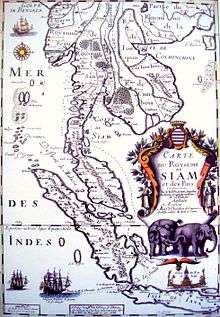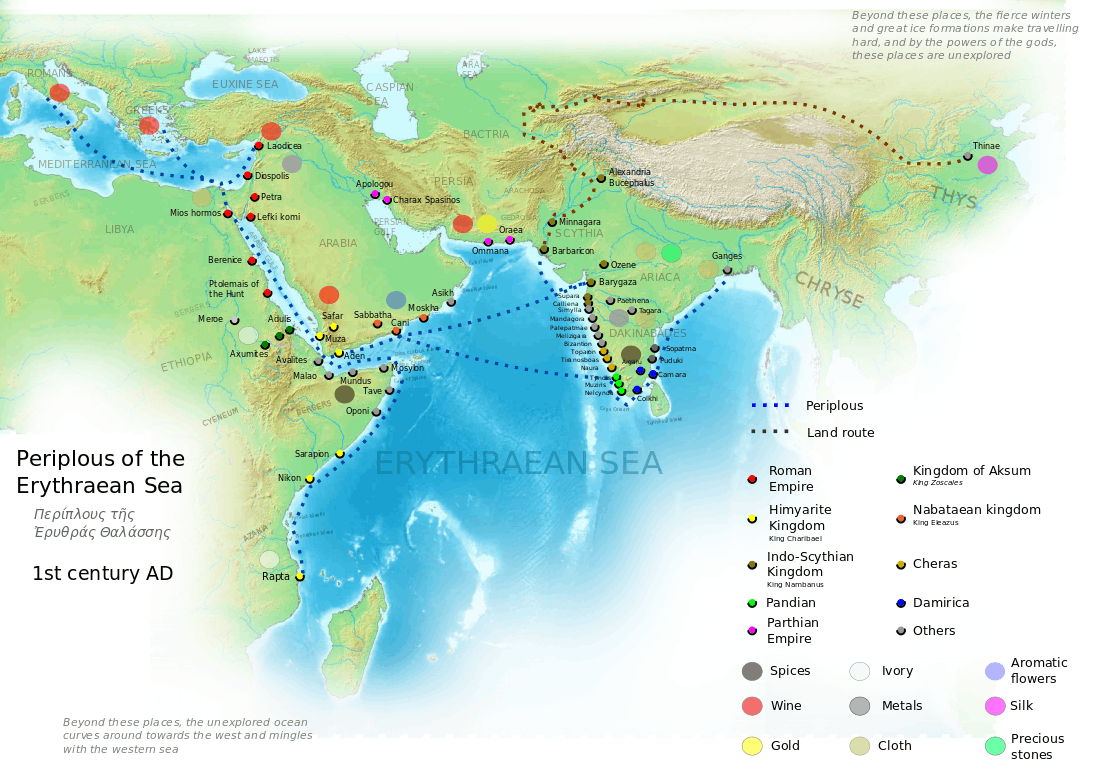History of Kedah
Part of a series on the |
|---|
| History of Thailand |
 |
|
Legendary Suvarnabhumi Central Thailand Dvaravati Lavo Supannabhum Northern Thailand Singhanavati Ngoenyang Hariphunchai Southern Thailand Pan Pan Raktamaritika Langkasuka Srivijaya Tambralinga Nakhon Si Thammarat Sultanate of Pattani Kedah Sultanate |
| History |
|
Sukhothai Kingdom Ayutthaya Kingdom Thonburi Kingdom Rattanakosin Kingdom Military period Democratic period |
|
Regional history |
|
|
Kedah, also written as Queda, and known in the early days as Kedaram, Kidaram, Kalagam and Kataha by the Tamils, and Kalah or Kalaha by the Persians, is an early kingdom on the Malay Peninsula and an important early trade centre. Early west-coast trade centres are few in number as they were overshadowed by Kedah. Her nearness to the entrances to the Straits of Malacca — and more importantly — being on latitude 6° north of the equator, the same as Ceylon to the south of India, allowed ships sailing the Bay of Bengal in a sea lane heading due east or west between the two, were in little danger of becoming lost. The early transpeninsular routeway is part of the Sea trade route of the Spice Route for Arab, Persian, Tamil Nadu and India-to-China traders, as the route through the Straits does not seem to have been in general use. Early sea traders from the west, upon reaching the coast, engaged porters to transport goods by raft, elephant and man-carry along the rivers (Kelantan River, Pattani River, Pahang River, Muda River, Bernam River, Muar River, and others) to the opposite coast. The Sungai Muda in particular favoured the development of Kedah.
After the 7th century, Srivijaya subjugated Kedah, but due to her fame, Indian sources continue to depict Kedah. Early Kedah also supplied its own tin, and jungle products such as rattan, resin, honey, beeswax, elephants, ivory, areca nuts, sepang wood and black woods, as well as profiting from tax collections.
The early history of Kedah can be traced from various sources. From the prehistoric period to the archaeological site of Bujang Valley, the early Maritime trade of India, Persia, Arabs to the written works of early Chinese pilgrims and early Chinese records, the Hikayat Merong Mahawangsa (known as Kedah Annals) to Al-Tarikh Salasilah Negeri Kedah.
Origins
Austronesians began migrating to the Malay Archipelago approximately 3,500 years before present. It is now accepted that Taiwan is the cradle of Austronesian languages. Some 4,000 years ago, Austronesian began to migrate to the Philippines. Later on, some of their descendants started to migrate southwards to what is now Indonesia and eastwards to the Pacific islands.
Ancient history
Austronesians were great seafarers, colonising as far as New Zealand, Hawaii and Madagascar. In some regions they intermarried with the local inhabitants (Orang Asli, India, the Persian Empire, Arabs, Han Chinese, etc.), becoming the Deutero-Malays. Possibly as early as the 4th century BCE, Austronesians started to sail westwards in search of new markets for their products. They reached the eastern coast of southern India, initiating trade. Gradually, rulers from western Indonesia began to adopt Tamil-Indian cultural and political models. However, the earliest evidence of such models found so far have been dated to only the early 5th century.
Trade connections between western Indonesia and the Tamil Nadu region of Southern India from the 4th to 9th centuries CE seem to have been close during the reign of the Pallavas. These relations helped spread Indian culture and religion to the Malays, and also led to emergence of Indianized kingdoms such as Old Kedah (Kadaram), Langkasuka,[1] Funan, and Champa.[2]
Some Greco-Roman merchants in the 1st century CE described huge non-Indian ships coming from the east with rich cargoes, possibly from the Malay Archipelago. This would indicate that the Malay participated actively in Indian Ocean trade, and likely handled much of the traffic between Southeast Asia and India.
Three kinds of craft are described by the author of the Periplus: light coasting boats for local traffic, larger vessels of a more complicated structure and greater carrying capacity, and lastly the big ocean-going vessels that made the voyages to Malaya, Sumatra, and the Ganges.[3]
Kadaram
.svg.png)
In the middle of the 6th century, new waves of colonials from the Pallava Empire asserted themselves and engineered the break-up of the neighbouring Hindu state of Funan. Funan had, at that time, been in existence since the 1st century CE. The expatriate Pallavas must have been a formidable force to shatter such a long-established kingdom whose monarch had a significantly Pallava name: Rudravarman. Clearly, the fact that the people of Kadaram and those of Funan shared a common religion, culture and, possibly, a language, did not deter the Pallavas from widening their sphere of influence, to Funan's great misfortune.[4]
Medieval history

Early in the Medieval era, Kedah became part of Srivijaya (the dominant Malay state and a major power in the Indian Ocean trade). This led to rivalries with the Indian states, especially the Chola Empire from the 9th to 13th centuries CE. The Cholas had a powerful merchant and naval fleet in the Indian Ocean and the Bay of Bengal. In the early 11th century, Tamil Chola King Rajendra Chola I sent an expedition to invade Kadaram (Sri Vijaya) on behalf of one of its rulers who sought his assistance to gain the throne. A second invasion was led by Virarajendra Chola of the Chola dynasty who conquered Kedah in the late 11th century.[5] Chola dominance was brief, but effectively crippled the power of Srivijaya.
In ancient Kedah there is an important and unmistakably Hindu settlement which has been known for about a century now from the discoveries reported 1840s by Col. James Low, later subjected to a fairly exhaustive investigation by Dr. Quaritch Wales. Dr. Wales investigated no fewer than thirty sites round about Kedah . The results show this site was in continuous occupation for centuries, by people who under strong South Indian, Buddhist and Hindu influences.[6]
An inscribed stone bar, rectangular in shape, bears the Ye Dharma Hetu formula[nb 1] in South Indian characters of the 4th century CE, thus proclaiming the Buddhist character of the shrine near the find-spot (site I) of which only the basement survives. It is inscribed on three faces in Pallava script, or Vatteluttu rounded writing of the 6th century CE, possibly earlier.[2] One of the early inscription stones discovered by James Low, at Bukit Meriam and in Muda River, mention of Raktamrrtika. The word Raktamrrtika means ‘Red Earth’ (Tanah Merah).
Inscriptions, both in Tamil and Sanskrit, relate to the activities of the people and rulers of the Tamil country of South India. The Tamil inscriptions are at least four centuries posterior to the Sanskrit inscriptions, from which the early Tamils themselves were patronizers of the Sanskrit language.[7]
In Kedah, an inscription in Sanskrit dated 1086 CE has been found. This was left by Kulothunga Chola I (of the Chola empire, Tamil country). This too shows the commercial contacts the Chola Empire had with Malaya.[7]
An indigenous style develops
The Tamils coming from Southern India and the local Malays were already using the rounded script, or Vatteluttu writing styles which differed from the Devanagari script of Northern India. Vatteluttu was also commonly known as the Pallava script by scholars of Southeast Asian studies such as George Coedes and D.G.E. Hall. The Tamil script of Vatteluttu later evolved into Old Kawi script which was used in Java, the Philippines, and Bali as well.
There are stone inscriptions which indicate that the Kedah region at 400 CE or before was already an established trade centre. One of the early Malay texts include the karma verses refers to a king named Ramaunibha, he may be the first local ruler whose name is recorded in history. The history of this period showed the influence of Indian cultures on the region while the locals in return, influenced the Indians in their living skills on the sea and in the hills.

See also
Notes
- ↑ Vinodh Rajan (2 April 2012). "Ye Dhamma - The Verse of Causation". Vinodh's Virtual Cyber Space. Archived from the original on 13 April 2012. Retrieved 13 April 2012.
The Pali verse 'Ye Dhamma... ' is a popular verse in Buddhism that explains the heart of Buddhism Philosophy i.e Dependant Origination. The Sanskrit version of the verse is called "Pratityasamutpada Hridaya Dharani" [The Heart Dharani of Dependant Origination] with Om added to the beginning of the Verse, and Svaha added at the end, thus Dharani-fying the entire verse. The Pali version never seems to have had any specific title.
References
- ↑ International Tamil Language Foundation (2000). The Handbook of Tamil Culture and Heritage. Chicago: International Tamil Language Foundation. p. 877.
- 1 2 Sastri, K.A. Nilakanta (1949). South Indian Influences in the Far East. Bombay: Hind Kitab Ltd. pp. 28 & 48.
- ↑ Sastri, K.A. Nilakanta (2000) [1935]. Cholas (fifth printing ed.). Chennai: University of Madras. pp. 86 & 318.
- ↑
- ↑ History of Asia by B.V. Rao p.211
- ↑ Sastri, K.A. Nilakanta (1949). South Indian Influences in the Far East. Bombay: Hind Kitabs Ltd. pp. 82 & 84.
- 1 2 Arokiaswamy, Celine W.M. (2000). Tamil Influences in Malaysia, Indonesia, and the Philippines. Manila s.n. p. 41.
Further reading
- The Encyclopedia of Malaysia: Early History, Volume 4 / edited by Nik Hassan Shuhaimi Nik Abdul Rahman (ISBN 981-3018-42-9)
External links
- The Geopolitical Situation
- Seafaring of India.
- The Development of Kedah's Early History Based on Archeological Finds
